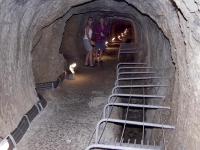
2. Invention
Who invented the Roman aqueducts?Here a set of questions with relevant answers, some of which are linked to related subjects as discussed in other places within this website www.romanaqueducts.info
Additional questions and remarks are most welcome via w.d.schram 'at' romanaqueducts.info
Questions
- Who invented the Roman aqueducts?
- What makes aqueducts Roman?
The water was carried in a pipeline at the bottom of a trench alongside of the floor of the main tunnel.
© Torben Bolhoj
Answer
Aqueducts were not a Roman invention. They were developed from older water conveying systems like the Persian qanat, a subterranean channel that taps a water bearing layer deep under the surface. The water is often used for irrigation and sometimes (also) for consumption. Some qanats are 4.000 years old.One of the earliest known aqueducts built above ground was the aqueduct of Jerwan. King Sennacherib of Assyria started construction on this aqueduct in 691 bc. This huge aqueduct carried water from the Greater Zab River to the king's fields and garden in Nineveh, which was over fifty miles away. A 30 foot high arched bridge was needed to support this aqueduct as it passed over a valley.
In 530 bc an interesting aqueduct including a tunnel of 1030 m in length was built on the island of Samos (Greece). The city of Rome (Italy) got its first Roman aqueduct in 312 bc: the Aqua Appia. Although aqueducts were not their invention, Romans were very good engineers and brought the design and construction of aqueducts to an all time high.